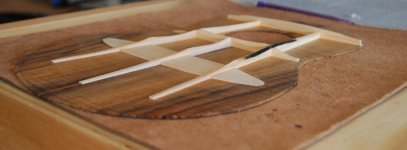Moore Bettah Ukuleles
Well-known member
Somewhere I recently read that "Most 'ukuleles are not made with fan bracing because it would make the soundboard too rigid." This is news to me but I tend to be a bit of a traditionalist when it comes to instrument construction. I was under the impression that most ukuleles were fan braced. So it got me to thinking and I'm just curious how you brace. I don't mean what you've tried; many of us have experimented with different bracing designs, but what you commonly use and what you are successful with. Personally, on my tenors I'll use between three and five fan braces depending upon what I'm trying to achieve. My sound boards tend to be pretty light and my bracing is extremely low in profile. What do you do?
Last edited:

